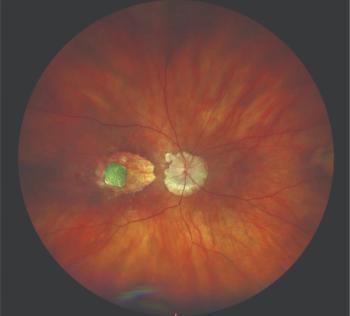
Budding technology could be an OCT analysis game-changer
Tools for higher-order OCT assessment enable evaluation of features of interest, such as targeted retinal layers or fluid compartments, and may allow for unique characterization of disease phenotypes and treatment response.
A cutting-edge image analysis platform for higher order OCT analysis successfully extracted novel fluid features and evaluated them for resolution extent and tempo, reported Justis P. Ehlers, MD.
“Current conventional OCT metrics used in most clinical trials are limited to global measures of retina thickness, retinal volume or perhaps manual linear measurements of areas of interest,” said Dr. Ehlers, Norman C. and Donna L. Harbert Endowed Chair of Ophthalmic Research at the
Dr. Ehlers noted that this is emerging technology.
“Further research is currently ongoing, including for subretinal material and sub-RPE feature extraction and layer-based assessment,” he said. “In addition, subvisual feature and radiomics interrogation of these data-rich images may provide unique insights into disease process and prognosis. Ultimately, these approaches may lead to the identification of imaging biomarkers for predicting optimal response to therapeutics, best dosing regimens, and overall prognosis.”
The novel analysis was applied to OCT scans collected in OSPREY, a 56-week, phase II study comparing brolucizumab (
For the final brolucizumab dosing cycle, the treatment interval was extended to 12 weeks.
RELATED CONTENT:
OCT analysis
For the novel OCT analysis, macular cube scans were uploaded into the software platform and segmented using an automated tool. Expert readers validated the segmentation accuracy.
The software analyzed volume and area of macular fluid within the intraretinal and subretinal fluid compartments. Analyses of the scans collected during the matched Q8 week treatment phase showed dramatic reductions over the course of the study in both intraretinal fluid volume and subretinal fluid volume with both anti-VEGF agents and a similar effect between brolucizumab Q12 week dosing and aflibercept Q8 week dosing.
“These findings from the preliminary assessments are consistent with the previously published anatomic data from the phase 2 OSPREY study,” Dr. Ehlers explained. “This exploratory post hoc analysis was not powered to demonstrate statistical significance. Further validation studies are needed using larger datasets.”
RELATED CONTENT:
Powerful potential
Dr. Ehlers noted that analysis platform has the capability of analyzing proportional reduction of volumes and could generate novel parameters, such as “true zero” fluid or “anatomically minimal fluid” (i.e., real-world dry retinas), and retinal fluid index (i.e., percentage of total retinal volume composed of intraretinal fluid).
“These new parameters could provide new insights about the rate and extent of fluid resolution, differential responses between anti-VEGF agents, and prognostic markers,” he concluded. “Targeted computational feature analysis in age-related macular degeneration, diabetic macular edema, and other retinal diseases may enable image-based phenotyping for risk-stratification and precision decision making.”
Disclosures:
JUSTIS P. EHLERS, MD
E: [email protected]
This article is adapted from Dr. Ehlers’ presentation at the 2019 meeting of the American Society of Retina Specialists. Dr. Ehlers is a consultant to Alcon, Allergan, Allegro, Genentech, Leica, Novartis, Regeneron, Thrombogenics, and Zeiss.
Newsletter
Don’t miss out—get Ophthalmology Times updates on the latest clinical advancements and expert interviews, straight to your inbox.





